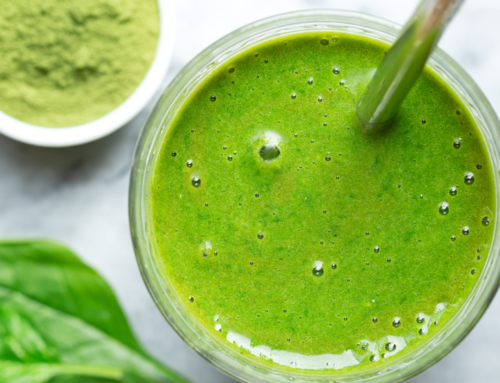Our team recommends products that we love and feel you will too. If you click through links we provide, we may earn a commission.
Shilajit is a natural substance popular in Ayurvedic medicine and has been used for centuries in Eastern cultures for a wide range of health benefits like improving energy levels and hormone imbalances. We don’t have a significant body of research to support its health benefits today, specifically shilajit benefits for women, but it’s traditionally used in Eastern medicine practices and functional medicine.
“Shilajit is brownish-black, sticky, mineral substance that comes from the rocks of mountain ranges, most notably, the Himalayas in India. It has been used in Ayurvedic medicine for thousands of years (1). Studies show that it has anti-inflammatory, adaptogenic, immunomodulatory, and antioxidant properties (2),” shares dietitian Megan Huff, RD.
Read on to hear from experts and learn the science behind shilajit and how you might use it in your routine.
Understanding Shilajit
Shilajit is a natural substance that originates from decomposed plant matter in mountainous regions. Particularly the Himalayas, Altai, Caucasus, and the Andes mountains produce this tar-like resin that oozes from the cracks of rocks during hot summer months.
The composition of shilajit includes fulvic acid, humic acid trace minerals, vitamins, and other biological compounds. Fulvic acid in particular has been named as one of the most beneficial nutrients that the supplement offers. While we don’t have a large body of modern science or research studies to support the health benefits, ancient texts like the Charaka Samhita and Sushruta Samhita describe shilajit as a potent remedy for a variety of ailments, including weakness, fatigue, aging, and digestive disorders. You can find shilajit in powder, capsule, and extract forms as a dietary supplement.
The Science Behind Shilajit
While the scientific research of shilajit is limited, there are a few reasons why many people report finding it helpful including cognitive function, energy metabolism, immune function, and antioxidant activity. Research suggests that shilajit’s bioactive compounds, including fulvic and humic acids, minerals, trace elements, and other organic substances, contribute to its health-promoting properties.
“Shilajit resin also contains more than 84 minerals, including many with beneficial effects on human health,” shares Dr. Starkey, N.D., is the VP of education and training at Trace Minerals.
Key compounds found in shilajit, such as fulvic acid, have been shown to have antioxidant and anti-inflammatory effects, meaning that they reduce the harmful free radicals and improve oxidative stress in the body. Fulvic acid also plays a role in enhancing nutrient absorption and energy production, potentially contributing to improved energy levels many consumers have shared.
Shilajit Benefits for Women
Improved Energy Levels and Stamina
Shilajit’s potential effects on hormonal balance and immune function may be of particular interest to women. While more research is needed to fully understand the mechanisms underlying shilajit’s effects in the female body, some evidence suggests that it may offer unique benefits for women’s health.
One of the ways shilajit may support energy levels is through its ability to support mitochondrial function. Mitochondria are the powerhouse of cells, responsible for producing the body’s primary source of energy. Bioactive compounds like fulvic acid, which have been shown to enhance mitochondrial efficiency and ATP production, potentially boosting cellular energy levels. Plus, shilajit may have adaptogenic properties that could help the body adapt to stress and make you more resilient to fatigue. By improving our body’s stress response pathways and supporting adrenal health, shilajit might help mitigate the impact that stress can have on energy levels.
Anecdotal evidence and testimonials from women who have incorporated shilajit into their wellness routine emphasize their change in energy levels. Some women report experiencing increased stamina, improved focus, and reduced feelings of fatigue after taking shilajit regularly. Case studies like these document the effects of shilajit supplementation on energy levels and fatigue in women – providing insight into its efficacy. Further research, including clinical trials and controlled studies, would help validate the specific mechanisms by which shilajit’s energy-enhancing effects take place.
Hormonal Balance and Menstrual Health:
Shilajit has anecdotally been reported to help women regulate their menstrual cycles and provide relief from painful menstrual symptoms like PMS. Perhaps, one mechanism of action for improved hormone balance is the bioactive compounds in the supplement, like fulvic acid.
Here are some commonly reported benefits for women’s hormone health:
- Regulation of menstrual cycles: Shilajit may have hormone-balancing effects that could help regulate menstrual cycles and promote more predictable ovulation and menstruation.
- Relief from PMS symptoms: Shilajit’s potential anti-inflammatory properties may help alleviate menstrual symptoms such as cramps, bloating, and mood swings.
- Improved fertility: Regular menstrual cycles are essential for fertility, and potentially regulating your hormonal health could have an impact on fertility in women struggling to conceive.
Enhanced Skin Health and Anti-Aging Effects:
Shilajit may play a role in increased collagen production which impacts how elastic our skin looks and feels. This could be a promising way to combat signs of aging in women. Collagen is the structure that provides the smooth, useful appearance most women seek when noticing the effects of aging.
Plus, with some research supporting that shilajit may be an antioxidant or have anti-inflammatory properties, this could contribute to its anti-aging side effects for the skin.
One contributing factor to aging is free radicals, which are cells that can turn into potentially dangerous cells, like cancer. A diet and lifestyle that is high in anti-inflammatory nutrients can help neutralize free radicals and slows signs of aging.
Cognitive Health and Mental Well-being:
Shilajit might have an impact on cognitive function and mood. Some research is being conducted on Alzheimer’s and cognitive function. One potential mechanism could be shilajit’s possible adaptogenic properties which can reduce stress on the body. Aside from the cognitive benefits, some women report experiencing reduced feelings of stress and anxiety and improved mood after incorporating shilajit into the routine.
How to Incorporate Shilajit into Your Routine
Shilajit comes in resin form, but you can find it in powders, gummies, and capsules for easy-to-take supplementation. The recommended dose ranges from 100 to 300 mg daily, but it’s important to discuss your goals with a healthcare provider and decide on the right dose for you. You can take the supplement on its own or some people mix it into yogurt or hot cereal in the morning for a nutritious boost.
Potential Side Effects and Precautions
Common side effects of shilajit may include digestive issues like upset stomach or diarrhea. To mitigate these effects, start with a low dose and gradually increase it while monitoring your body’s personal response. Make sure you’re staying hydrated to help alleviate digestive discomfort. For pregnant, nursing, or women with certain medical conditions like diabetes, hypertension, or autoimmune disorders, it’s not recommended to take new supplements without checking with your healthcare provider. Shilajit can interact with medications or exacerbate certain health conditions, so consult with your doctor before beginning a new supplement.
Shilajit Benefits for Women FAQ’s
Does shilajit increase estrogen?
Shilajit’s effect on estrogen levels is not well-documented in scientific literature, and research on this specific aspect is limited. However, many Ayurvedic medical practitioners recommend shilajit to increase estrogen levels in the body.
If you have concerns about estrogen levels or hormonal balance, it’s advisable to consult with a healthcare professional who can provide personalized guidance based on your individual health needs and circumstances.
How long does it take to experience the benefits of shilajit for women?
“Shilajit is a natural ayurvedic product and most of the time, you may expect to see the effect in about 3 months,” explains Moushumi Mukherjee, MS, RDN.
It may take time to notice any improvement in your symptoms when taking Shilajit. Some people find that symptoms like energy improve quickly whereas other symptoms like hormone and skin help take more time to notice a difference.
As with any supplement or natural remedy,individual responses to shilajit can vary, and some women may experience benefits sooner or later than others. Additionally, results may also depend on the quality and purity of the shilajit product being used.
Are there any potential side effects of shilajit for women?
Potential side effects for women include gastrointestinal discomfort, allergic reactions, and interactions with medications such as blood thinners or diabetes medications. Heavy metal contamination is also a concern, particularly with products sourced from the environment. Pregnant and breastfeeding women should avoid shilajit due to limited safety research.
It’s crucial to consult with a healthcare professional before starting a new supplement, especially if you are pregnant, breastfeeding, or taking medications, and to monitor your symptoms for adverse effects while gradually increasing dosage. If any concerning symptoms occur, discontinue use and seek medical advice promptly.
Can shilajit help improve skin health and reduce signs of aging in women?
Yes, shilajit’s bioactive compounds stimulate collagen synthesis, promoting skin firmness and elasticity, thus potentially reducing wrinkles and sagging skin. Additionally, its potent antioxidant properties protect against oxidative damage, preventing premature aging and maintaining youthful skin. While further scientific research is needed, anecdotal evidence suggests shilajit could be a valuable addition to women’s skincare routines, complementing sun protection, hydration, and a balanced diet for healthy skin.
Who should avoid taking shilajit?
Those who are pregnant or breastfeeding, and individuals with underlying health conditions, allergies to its components, heavy metal sensitivities, and children due to the lack of safety data. Consulting a healthcare professional before use is essential, especially if there are concerns about interactions with medications or specific health conditions. Opting for high-quality shilajit products from reputable sources is crucial to minimize the risk of contamination and ensure safety and efficacy.
Conclusion
Shilajit may offer several key benefits for women’s health, including potential improvements in energy levels, cognitive function, mood regulation, hormonal balance, and skin health. As a natural supplement rich in bioactive compounds, shilajit has been traditionally used and increasingly studied for its diverse health-promoting properties. Incorporating shilajit into a balanced lifestyle, along with proper nutrition, exercise, and stress management practices, may have health-promoting properties.
Sign Up For Our
Deals Newsletter
Receive exclusive deals from our favorite brands.







